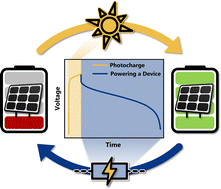Organic photo-battery with high operating voltage using a multi-junction organic solar cell and an organic redox-polymer-based battery†
Abstract
The demand for small energy devices capable of powering consumer electronics in the frame of the Internet of Things is ever increasing. The constraints placed on the size of these devices requires the design of power sources in the most compact way, for which a viable solution is the combination of energy harvesting and storage in one power pack. Herein, we report on a fully integrated monolithic organic photo-battery, consisting of an organic polymer-based battery, powered by a multi-junction organic solar cell capable of charging up to voltages as high as 4.2 V under varying illumination conditions. The full device demonstrated fast photo-charging within minutes and supplied on-demand discharge capacities of up to 22 mA h g−1 (regarding battery active material) with average discharge potentials of 3.6 V vs. Li/Li+. The combined device constitutes the first monolithically integrated photo-battery made from organic building blocks capable of reaching competitive voltages sufficiently high for use in small, mobile power devices.

- This article is part of the themed collection: Recent Open Access Articles


 Please wait while we load your content...
Please wait while we load your content...